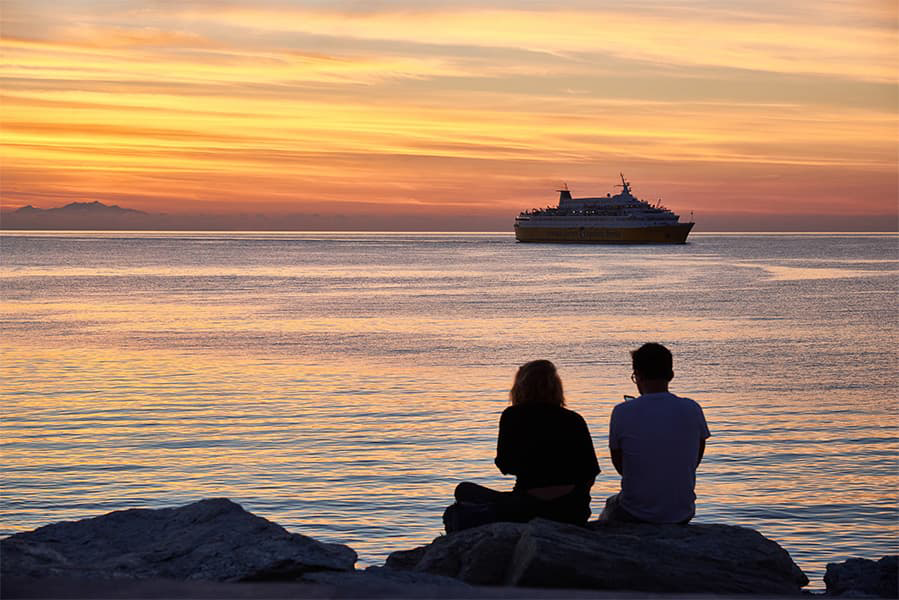Vulcano – Filicudi
Ferry to Aeolian Islands
Vulcano – Filicudi
Ferry to Aeolian Islands

Depending on the season their are usually 3 daily and 20 weekly sailings between Vulcano and Filicudi. 2 ferry operators provide the ferries from Vulcano to Filicudi, Liberty Lines Fast Ferries & Siremar. Vulcano Filicudi ferries take around 1 hour 30 minutes. The ferry costs between $65.38 and $108.39, depending on ticket details. Prices exclude any service fees. Ferry timetables change seasonally, use our Deal Finder to get live pricing and availability for ferries from Vulcano to Filicudi.
The earliest Vulcano Filicudi ferry typically departs Vulcano at about 07:30 and the last ferry usually leaves at 15:55.
Ferries from Vulcano to Filicudi sail in around 1 hour 30 minutes. The fastest ferry is approximately 1 hour 25 minutes. Ferry duration can vary by ferry provider and can be impacted by weather conditions.
There is 20 weekly sailings from Vulcano to Filicudi provided by Liberty Lines Fast Ferries & Siremar. Timetables can change from season to season.
Liberty Lines Fast Ferries provide 17 sailings weekly. Siremar provide 5 sailings weekly.
The price of a ferry from Vulcano to Filicudi typically range between $65.38* and $108.39*. On average the Vulcano Filicudi ferry is $76.70*. The cheapest Vulcano Filicudi ferry prices start from $65.38*. The average price for a foot passenger is $76.70*.
Pricing will vary depending on number of passengers, vehicle type, route and sailing times. Pricing is taken from searches over last 30 days and exclusive of service fees, last updated 1 April 2025.
The distance between Vulcano to Filicudi is approximately 28 miles (45km) or 24 nautical miles.
Yes, Vulcano Filicudi ferries allow cars onboard with Siremar between Vulcano and Filicudi. To view car ferry tickets and prices between Vulcano and Filicudi use our Deal Finder.
Liberty Lines Fast Ferries & Siremar allow foot passengers on Vulcano Filicudi ferries.
Liberty Lines Fast Ferries allow pets on ferries from Vulcano to Filicudi. Please also note that your pet may have to stay in the vehicle during the journey.
More routes than anyone else.

Compare fares, times & routes in one place.
Change plans easily with flexi tickets.

Book e-tickets & manage trips in-app.
Live ship tracking & real-time updates.

Top-rated customer support when you need it.
The small Italian volcanic island of Vulcano lies in the Tyrrhenian Sea and is around 25 km to the north of Sicily, and is the most southerly of the eight islands that make up the Aeolian Islands. The island is only around 21 sq. km and its highest point is just under 500 m above sea level. There are a number of volcanos on the island, and includes one of four active, non-submarine, volcanoes in Italy. The most recent volcanic activity is the Gran Cratere at the top of the Fossa cone, the cone having grown in the Lentia Caldera in the middle of the island, and has had at least 9 major eruptions in the last 6,000 years. However, the island's volcanoes have been quiet since around 1890 when Fossa erupted and deposited around 5 meters of pyroclastic material on the summit. The island is also famous for its hot springs which are located a short walk from the harbour. For the brave, visitors are able to walk to the crater of a volcano where you can observe smoke coming out of the ground!
Hydrofoil and ferry services connect Vulcano to the other Aeolian Islands and to Sicily and the mainland. Access from Milazzo in Sicily is convenient, as Vulcano is the boat's first stop from there as they continue to the other islands.
The Italian island of Filicudi is one of the Aeolian Islands and lies off the north east coast of Sicily and is popular with scuba divers. A large part of the volcanic island is now designated as the "Natural Reserve of Filicudi Island". The island is made up of several layers of lava with oldest being located in the sea in front of 'Fil di Sciacca' with the largest being 'Fossa delle felci' and the most recent being 'Montagnola'. The island's slopes tend to be steep and rocky with houses located around the "Porto Pecorini" and "Valdichiesa" where the Church of St. Stephen, the island's patron saint, can be found.
To the north of the island is the spectacular “Punta Zucco Grande” (with ten layers of lava) with the eastern side of the island being a less harsh environment. Perhaps the most beautiful landscapes on the island are the “Punta Perciato” and the giant boulders of the “Rupi delle Sciare” ["Cliffs of the ‘Sciara’”], which are steep vertical cliffs overlooking the sea.